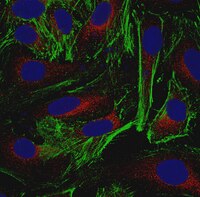MABT826 Sigma-AldrichAnti-Actin Antibody, clone 2G2
Anti-Actin Antibody, clone 2G2 is an antibody against Actin for use in Immunocytochemistry, Western Blotting.
More>> Anti-Actin Antibody, clone 2G2 is an antibody against Actin for use in Immunocytochemistry, Western Blotting. Less<<Produits recommandés
Aperçu
| Replacement Information |
|---|
Tableau de caractéristiques principal
| Species Reactivity | Key Applications | Host | Format | Antibody Type |
|---|---|---|---|---|
| H, M, Ch, R, Fg, Rb, Mk | ICC, WB | M | Purified | Monoclonal Antibody |
| References |
|---|
| Product Information | |
|---|---|
| Format | Purified |
| Presentation | Purified mouse monoclonal IgMκ antibody in PBS with 0.05% sodium azide. |
| Quality Level | MQ100 |
| Physicochemical Information |
|---|
| Dimensions |
|---|
| Materials Information |
|---|
| Toxicological Information |
|---|
| Safety Information according to GHS |
|---|
| Safety Information |
|---|
| Storage and Shipping Information | |
|---|---|
| Storage Conditions | Stable for 1 year at 2-8°C from date of receipt. |
| Packaging Information | |
|---|---|
| Material Size | 100 µL |
| Transport Information |
|---|
| Supplemental Information |
|---|
| Specifications |
|---|
| Global Trade Item Number | |
|---|---|
| Référence | GTIN |
| MABT826 | 04055977312393 |
Documentation
Anti-Actin Antibody, clone 2G2 FDS
| Titre |
|---|
Anti-Actin Antibody, clone 2G2 Certificats d'analyse
| Titre | Numéro de lot |
|---|---|
| Anti-Actin, Clone 2G2 - 3958307 | 3958307 |
| Anti-Actin, Clone 2G2 - 4122561 | 4122561 |
| Anti-Actin, Clone 2G2 - 4191170 | 4191170 |
| Anti-Actin, clone 2G2 - 3352428 | 3352428 |
| Anti-Actin, clone 2G2 - 3918574 | 3918574 |
| Anti-Actin, clone 2G2 -Q2639120 | Q2639120 |
| Anti-Actin, clone 2G2 Monoclonal Antibody | 3041694 |
| Anti-Actin, clone 2G2 Monoclonal Antibody | 3096936 |








